
The “tax gap” — the amount of taxes Americans owed but failed to pay — reached almost half a trillion dollars a year for the years 2008 through 2010 — an average annual loss of $458 billion, according to an analysis by the Internal Revenue Service.
That led Republicans in Congress to go on the warpath, naming the closing week of April “IRS Week” and summoning the IRS chief, John Koskinen, to answer for the agency’s appalling inefficiencies in four hearings over eight days conducted by efficiently overlapping congressional committees.
To vent its wrath, the Republican-controlled House passed half a dozen measures to penalize the tax agency. “House Republicans are finding new ways to rein in the IRS”, said the conservative Weekly Standard. No bonuses until service improves, is one of them. Senator Orrin Hatch, Republican of Utah and chairman of the Finance Committee, said the IRS should to do a better job. “This recent data further underscores the need for the IRS to get smarter about guaranteeing tax compliance and restore trust and faith in the agency”. House Speaker Paul Ryan, Republican of Wisconsin, said much the same: “Right now, we have a tax code that no one can understand being enforced by an agency that no one trusts”. House majority leader Kevin McCarthy, Republican of California, called the agency “a picture of government corruption and incompetence.”
Some Democrats joined in. Senator Ron Wyden of Oregon is angered by corporations dodging some $400 billion in taxes over the past 10 years. “It’s time the IRS put an effective tracking and auditing system in place to locate this lost money”.
running on fumes
So how is the IRS to “get smarter” and pay for tracking and auditing systems? These same legislators in the House and Senate have seen fit to cut the IRS budget every year from 2010 through 2015 for a total of $1.2 billion, causing the agency to shrink by 17,000 employees. At the same time the number of taxpayers in the U.S. has risen by 10 million. And, of course, it is also these legislators who have, over the years, concocted a tax code of grotesque complexity, without consultation with the IRS, only to leave it to the agency to administer their absurd minutiae of rules in unavoidably tangled worksheets on the tax forms. “Life would be simpler for taxpayers and simpler for us if the tax code were simpler”, IRS chief John Koskinen says. But Congress talks endlessly about tax reform while doing nothing.
bombardment
The pattern is for Congress to choke off funding to produce results to complain about, hopefully as cameras whir in committee hearings for their voters to see on local nightly news. This sham continues at precisely a time when the IRS needs to be strengthened. The service has been beset with a host of new problems, most notably a security breach in 2015 that netted hackers data on some 700,000 tax filers. Along with the revelations exposed by people using social media, such data equips cyber-thieves with the personal identity-verification answers needed to impersonate actual taxpayers and divert refunds to themselves. The number of attempts quadrupled to 730,000 between 2010 and 2014. The agency estimates that there are about a million attempts each day to illegitimately access taxpayer accounts. Koskinen reports that these attempts have shifted beyond individuals looking for a payday to organized crime syndicates that require more rigorous defenses against break in.
But Congress expects the IRS to combat these new assaults with 5,000 fewer revenue agents, officers and criminal investigators than five years ago. That didn’t stop Representative George Holding (R-NC) from complaining to Koskinen that the IRS is not trying hard enough to catch criminals, saying, “You can’t deter crime unless you prosecute crime”.
And of course there is the worldwide problem of the wealthy hiding money offshore, most recently evidenced by the leak of names from a Panama law firm.
irs political tempest
Republicans are irate at the IRS for selectively sidelining conservative groups applying for tax-exempt status during the 2012 presidential campaign. They had applied as the 501(c) “social welfare” form of organization that avoids the disclosure of donor names that other classifications require. A Cincinnati unit charged with vetting these groups had filtered out those with words like “tea party” or “patriot” in their titles for special scrutiny. (It was later shown that the group had filtered for Democratic political groups as well, but that didn’t make much headway in the media). That these groups claim they exist for “promoting the common good and general welfare of the community as a whole” is, of course, risible. Stung by the 2012 episode, the IRS this year even granted that status to Karl Rove’s Crossroad GPS PAC, a testament to how compromised the system is. Such groups are entirely political, but the IRS has to go along else risk still further defunding.
Republicans have ever since used the indiscretion of that Cincinnati office to characterize the entirety of the IRS as corrupt. It happened before Koskinen came on board, but now, 
IRS Commissioner John Koskinen
having “agitated” for months, House Republicans have apparently persuaded the leadership to pursue the impeachment of Koskinen for “misconduct” having to do with lost e-mail transmissions during the scandal.
The misdeeds of that one unit, which stands well apart from the main business of the IRS, is used by demagogues such as Ted Cruz as grounds for abolishing the IRS altogether and to claims of Majority Leader McCarthy that “thousands of IRS employees are delinquent on their own taxes”. That willful distortion proved instead to be an average of 160 employees a year over 10 years out of a work force of 85,000. In its Caesar’s wife position, the IRS stands watch; employees who are delinquent in filing are subject to disciplinary action. Koskinen says “the IRS has the highest compliance rate by far of any federal agency or any congressional operation”. Was Koskinen perhaps thinking of Sen. Bob Corker (R-TN), who was discovered by the Wall Street Journal to have failed to disclose $3.8 million of income from hedge funds and real estate? Corker apologized for the “oversight”. No problem, Bob. All was forgiven. Such are Senate ethics.
no answer
The budget cuts voted by Congress have led to huge declines in IRS service to taxpayers and howls of complaint from Congress members who cut the budget. Lack of funds has led to a backlog of almost a million pieces of unanswered correspondence from taxpayers. Wait time for callers with questions went from 10 to 24 minutes in 2015, fanning the incompetency pronouncements by Congressional members who seem to have difficulty correlating those funding cuts with the inability of the IRS to hire people to answer phones. Feeling the heat of constituent complaints, they did make that connection this year — it’s an election year — and for the first time in five years voted an increase in the IRS budget of $290 million. But the new money was earmarked to be used only for voter concerns: taxpayer service, cyber-security and identity theft. As for service, a low of 37% of callers getting through shot up to 70%. Not enough but, as Koskinen says, “It’s a direct line of, if you give us the money, and we can hire people, they will be able to answer the phone”.
money left on the table
Of the 17,000 employees lost to budget cuts since 2010 when Republicans gained control of the House (it originates funding bills), 5,000 were engaged in enforcement. Yet they are the moneymakers. Koskinen says that “every dollar invested in us returns at least $4 to the Treasury” but the ratio for enforcement personnel is much higher — more like $10 for every $1 spent, he says.
So by what illogic does Congress cut IRS funding? The answer is that it is deliberate, deeply cynical and corrupt. The biggest targets for enforcement audits are the deep pockets that pay for Congress members’ election campaigns. So Congress makes certain the agency doesn’t have the money for enforcement personnel and it restricts use of money to other purposes. Taxpayer service, as we just saw.
The result? Audits are at an 11-year low with the number of tax enforcement employees down 24% from 2010. Last year the IRS audited 1.2 million individual tax returns out of 147 million, the fewest in a decade. That’s less than 1%, sacrificing revenue that runs to many billions of dollars. Doesn’t that add to the government deficit that so upsets conservatives in Congress? It is difficult not to conclude that lurking behind this charade is the “starve the beast” agenda of the ultra-right that hopes to deprive the government of funds so as to reduce it, in Grover Norquist’s memorable image — he runs an organization that fights all forms of taxation — “to the size where I can drag it into the bathroom and drown it in the bathtub”.
That leaves Koskinen to find other means to go against those who work to hobble or abolish the essential agency that funds the government. To beef up enforcement he has found a way — mostly by attrition of other categories of personnel — to hire and train 700 new enforcement agents, “the first significant enforcement hiring in more than five years”, he says. Serving up more proof that Republicans do not welcome efforts to increase revenue for the government, chairman of the House Oversight and Government Reform Committee, Jason Chaffetz (R-UT) is demanding to know how Koskinen has found the money to hire the 700 staffers. Chaffetz, whose only job before politics was in public relations for “multi-level marketing” firm
Nu_Skin International (which had been the target of an Federal Trade Commission investigation), apparently doesn’t grasp that simple attrition could provide openings for all 700 in an IRS of 85,000. Instead, in a letter reminding Koskinen that he had just asked in February for a $1 billion funding increase, Chaffetz wrote, “The inescapable conclusion is that your testimony to Congress was inaccurate, reflecting either an attempt to exaggerate IRS’s budget needs or a management failure in understanding the needs of your organization”. In Chaffetz’s math, having found a way to hire 700 enforcement agents has extinguished the need for the billion dollars at an agency that is short 17,000 employees.
Moreover, though, despite the new hires, the IRS will still end fiscal 2016 with 2,000 fewer workers than it started. So goes Congress’ war to hobble the IRS.
Koskinen knows better than to assign the new hires to forensic work examining high income earners and risk budget retaliation from lawmakers concerned for their campaign donors. So he has carefully made the point that the new agents will be deployed to go after low-yield taxpayers — small businesses and the self-employed. Apparently, the 1% at the top won’t be inconvenienced.
May 31 2016 | Posted in
Politics |
Read More »
Changes in overtime rules announced by the Obama administration have businesses in an uproar. Currently, they are required to pay extra for overtime only to workers who are paid a salary of less than $23,660 a year ($455 a week). That threshold is set to soar to $47,476 ($913 a week). Come December 1st, anyone earning less than that doubly high threshold becomes eligible for time-and-a half pay for work in excess of 40 hours a week. The rule does not apply to those whose work is classified as executive, administrative or professional.
Businesses complaining the most are those paying little more than the current $455 threshold while requiring more than 40 hours of work for no extra pay. In the more extreme cases that can equate to less per hour than the federal minimum wage.
In the more general case, to adjust, employers are expected to reallocate work to curtail hours, fill in with part-time workers, raise the pay of those near the new threshold to just above it to avoid the overtime mandate, or cut salaries of those now working long hours such that added overtime pay amounts to the same paycheck.
nothing new
Obama is making the change in accordance with a 78-year-old law, the 1938 Fair Labor Standards Act, which empowers the president to set overtime rules. “Overtime’s a pretty simple idea”, said Obama in announcing his intentions over two years ago. “If you have to work more, you should get paid more”. The huge increase to $47,476 is simply to adjust a rule that has been unchanged since 1975. The $23,660 threshold set in that year under the Ford administration qualified 60% of the salaried workforce for overtime compensation. Inaction ever since has allowed inflation to reduce that dollar cutoff so far that most workers today are above it, are therefore paid no more than a fixed salary, with a mere 7% now qualifying for overtime.
The correct adjustment for inflation would have been about $51,000 ($980 a week), but this was judged to be too high for certain areas of the country such as the South. The somewhat lower level of $913 a week is expected to make around 4.2 million more workers overtime eligible, and it will ratchet up every three years, tracking wages in the South.
reversal
Partly, Obama’s move is to turn back George W. Bush’s revisions. Bush
favored business with hundreds of pages of new rules [1] put in place in 2004 that removed scores of job descriptions from overtime eligibility, cutting the earnings of what Democrats and labor estimated to be six million workers. The Bush administration estimated only 107,000 would be affected and somehow claimed the rules exempting categories of worker from overtime would add 1.3 million workers to the overtime eligible ranks.
The Bush rules gave business owners extraordinary latitude to classify work. As an example, a supermarket employee who normally unpacked shipments but was made to spend 5% of hours on tallying inventory could be classified entirely as “administrative” and denied overtime altogether.
objections
For some businesses, the change means switching employees from a fixed salary to keeping track of their hours, returning to a computerized version of workers punching in with time cards, and bearing the added overhead of calculating payroll. The National Retail Federation estimates that a third of workers in that field will be shifted from salary to hourly.
But some of the arguments against are feeble. The switch from salaried to hourly will undermine employee morale, goes one forewarning. The Department of Labor is effectively demoting millions, says another, because lowly-paid workers classified as management (solely to avoid overtime) will suffer a loss of prestige. The better bet is that employees will be overjoyed to be making more money.
What may seem to be just another executive overreach is in fact fixing a law so neglected as to be moribund. The fix raises an overtime threshold that should have been continuously adjusted all along to where it should be now. There are plenty of businesses that have all along benefited from the neglect by forcing workers to work 50-60 hour weeks — opening stores in the morning and cleaning and closing them at night, for example, while paying them nothing extra and threatening to fire them if they complain. These employees will finally have recourse. Businesses will have difficulty adjusting, but those that object outright to the correction are essentially saying there should be no law to protect workers from exploitation.
Under the Congressional Review Act, Congress has 60 legislative days in which to overturn the regulation by simple majority not subject to filibuster. Voting against workers in an election year could be hazardous.
May 31 2016 | Posted in
Economy |
Read More »
With U.S.-Saudi relations at low ebb, the bill moving through Congress — just passed unanimously by the Senate — that would permit the families of 9/11 victims to sue the kingdom for its alleged involvement has led to threats. As retaliation the Saudi foreign minister came to Washington to say the kingdom would unload some $750 billion of U.S. assets lest they might be frozen if the lawsuit were allowed to go through.
The Obama administration has lobbied hard against the bill, infuriating those families, who effectively represent some 2,600 Americans and almost 400 from 90 countries who lost their lives in the September 11, 2001 attacks, and who find it inexplicable that their government favors the Saudis over the lives of its own people.
the 28 pages
The bill, which has broad bipartisan report, has again raised the question of why the American 
President Bush with then Crown Prince Abdallah,
now King Salman of Saudi Arabia.
public is not allowed to see 28 pages that were removed from the 2002 report of the joint congressional investigation of the attacks. That those pages have been locked away in a secure basement room in the Capitol building for going on fourteen years fairly shouts that the Saudis have something to hide so inflammatory that first George W. Bush, and now Barack Obama for almost eight years, have seen fit to protect the Saudi royal family. President Obama has twice, and in-person, assured family members that he would have the pages released, but has gone back on his pledge. Obama is clearly running out the clock.
The media have been more concerned with Congress’s bill, a troublesome foray into foreign policy, and the White House response, and has made only passing mention of the missing pages, but that’s the far bigger story that follows.
Release imminent? : Director of National Intelligence James Clapper says the 28 pages will be made public as early as June. However, asked in a 2013 Congressional hearing whether or not the NSA collected “any type of data at all on millions of Americans”, Clapper notoriously answered “No sir,…not wittingly”. So it remains to be seen if Clapper can be trusted this time.
FAMILY TIES
That Osama bin Laden and 15 of the 19 hijackers were Saudis is more than a coincidence. That special considerations were given to Saudis in this country immediately after the attacks is at the root of the government spiriting away the report’s pages. In his book, “House of Bush, House of Saud”, Journalist Craig Unger outlines connections between the Saudis and American business interests over decades that exchanged “lucrative oil deals” for American military protection.
No strangers to the oil patch, the Bush family had developed a close relationship with the Saudi royal family. Prince Bandar bin Sultan, the Saudi ambassador to the United States spanning four presidents, “was so close to the President’s father, George H. W. Bush, that he was considered almost a member of the family”, Unger writes. Obviously under orders from George W. Bush, days after 9/11 the FBI facilitated the departure from the U.S. of some 160 Saudis, 
President George W. Bush meets with Prince Bandar bin Sultan, the Saudi Ambassador to the United States, on August 27, 2002, at Bush’s ranch in Crawford, Texas.
even including members of the large bin Laden family, on specially chartered flights. The Saudis fled in fear of retribution, but whereas the FBI said it questioned those departing, the speedy exodus of so many couldn’t have allowed for very thorough vetting, skeptics point out, and documents say several were never questioned. The interviews were disparaged as “courtesy chats” by a former Army interrogator who is now director of intelligence at Judicial Watch, a rightist watchdog group.
the 28 pages
The George W. Bush administration immediately removed and classified the 28-page section of the 2002 congressional investigation of the 9/11 attacks. Release of the chapter “would make it harder for us to win the war on terror”, was Bush’s elliptical explanation. Two lawmakers — Reps. Walter Jones (R-NC) and Stephen Lynch (D-MA) — read the redacted pages and, bound by secrecy law, could only say they have nothing to do with national security. They were “absolutely shocked” to learn that a foreign state had a high level involvement in the attacks. They were certainly referring to Saudi Arabia.
In a 2014 New Yorker investigative article, al Qaeda authority Lawrence Wright traces connections between the Saudis’ Ministry of Islamic Affairs and two Saudi hijackers who slipped CIA surveillance in Malaysia and entered the United States undetected at Los Angeles.
That ministry turns out to be the same front that we alluded to in our 2014 article, “Arabs Tell U.S., ‘You Do the Fighting’ “, where we say, “the Saudis send emissaries to their embassies and consulates in Muslim and other countries to promote Salafism”, the severe form of Islam at the core of ISIS. The lawsuit brought by the wives of the 9/11 victims claims that charities managed by the ministry in the U.S. were in fact conduits for funding al Qaeda with Americans’ donations. The suit claims that money contributed over three years by Prince Bandar’s wife found its way into al Qaeda coffers, and the suit therefore names the kingdom of Saudi Arabia as a defendant.
Wright exposed what may be found in the 28 pages: the assistance reportedly given to the two Saudis — Nawaf al-Hazmi and Khalid al-Mihdhar — who had come to Los Angeles to somehow, somewhere, learn to fly Boeing jetliners. They spoke no English, so they clearly needed help. They were given it by a Saudi named Omar al-Bayoumi, who lived in San Diego where he nominally had a job with a Saudi aviation services company for seven years but never seemed to show up for work. Even his Arab circle of friends thought he was a spy.
And indeed, he was connected to the Islamic affairs ministry. On the one day that al-Bayoumi made an infrequent trip from San Diego to Los Angeles to call at the ministry, he just happened to connect with the two would-be hijackers. He told investigators he overheard the two speaking with a Gulf accent at a restaurant where he and a friend stopped for lunch. Al-Bayoumi struck up a conversation and offered to help, moving them to San Diego and introducing them to the Arab community there. Leaks about the missing pages say that a Saudi government official helped the two find an apartment and co-signed the lease. Another handler was wired $130,000 by the Saudi ambassador to the U.S. — at the time, Prince Bandar. Yet the FBI was actively prohibited by the Bush administration from investigating those links.
The way was paved for the two Saudi hijackers to learn to fly. Could Saudi ministry officials claim this was just a helping hand extended to two countrymen, lost in America without even English, unaware of or unquestioning of their puzzling mission to learn to fly commercial passenger jetliners?
Just last year, more came to light. Zacarias Moussaoui, a French citizen of Moroccan descent believed to have been the intended 20th hijacker 
Zacarias Moussaoui
in the 9/11 attacks had he not been arrested weeks before, testified from his federal “supermax” prison in Colorado that members of the Saudi royal family were contributors to al Qaeda in the 1990s. He also says that in Afghanistan he once discussed with a member of the Saudi embassy in Washington how the American president’s aircraft, Air Force One, might be brought down with a Stinger missile. He said he was supposed to return to Washington with the embassy official to scout for shoot-down locations, but his arrest intervened.
Moussaoui’s testimony, if true, suggests that what is in those classified pages may prove to be far more incendiary than previously imagined. In response to his allegations, the Saudi embassy here called him a “deranged criminal…whose words have no credibility”. At the time of his trial, his lawyers had Moussaoui diagnosed as mentally ill, but he was deemed competent enough to stand trial. In the recent testimony “my impression was that he was of completely sound mind — focused and thoughtful”, according to Sean Carter, a lawyer for the plaintiffs in the deposition.
ASKED TO TESTIFY
The lawsuit brought against Saudi Arabia by relatives of those killed in the attacks was originally brought in 2002 and has dragged on so long, fought strenuously by the Saudis who have claimed sovereign immunity, that The New York Times likens it to Jarndyce v. Jarndyce of Charles Dicken’s “Bleak House”.
Moussaoui asked to testify. He had made the request in a letter to the presiding judge. Proof enough that he was not prompted to do so — and why would the government pressure him to reveal what they would prefer be kept secret — is that “lengthy negotiations with Justice Department officials and the federal Bureau of Prisons” preceded his being allowed to come forward.
Justice Department lawyers came away with 100 pages of testimony in which Moussaoui says he had acted as a messenger for Osama bin Laden. That had caused him to come in direct contact with various members of the Saudi royal family. Most notable among them, he says, was Salman bin Abdulaziz Al Saud, who is now king of Saudi Arabia. The purpose was to raise money, first for militants fighting the Russians in Afghanistan and then for what they became: al Qaeda.
Bin Laden had Moussaoui develop a database of donors to al Qaeda. Moussaoui says his list included the Saudi intelligence chief, Saudi clerics who promoted an extreme brand of Islam called Salafism, and Bush friend and ambassador Prince Bandar.
NONE OF OUR BUSINESS?
Both the Bush and Obama administrations have run interference for the Saudi regime during the entirety of their presidencies, 
President Bush with then
Crown Prince Abdallah of Saudi Arabia
a regime that that we now hear has allegedly funded al Qaeda from the highest levels of the royal family, a regime that has funded a virulent form of Islam throughout the Muslim
President Obama with now King Salman
world that has spawned ISIS, a regime that has left it to the U.S. to combat it. It is no surprise that our government has a lot to hide from the American people.
There seems to be general agreement that the 28 pages should be declassified. The heads of the 9/11 commission, former New Jersey Governor Thomas Kean and former Indiana Congressman Lee Hamilton, agree. Their view is there is no justification for holding back whatever we know about those who plotted and executed the 9/11 attacks. A concern for “embarrassing” the Saudis is an insupportable reason for suppression.
<|46|120|>
A U.S. guided missile destroyer sailed last week within 12 miles of an artificial island constructed by China to symbolically insist that navigation of the seas will remain free, that the international convention’s 12-mile exclusion can only be declared by a sovereign owner of territory, and that disputed Fiery Cross Reef does not belong to China.
Yet now China is moving still further from its takeover of certain of the Spratly and Paracel Island chains to Scarborough Shoal, clearly far from China and on the edge of the Philippines (click map to expand). 
Simultaneously, China says it will build floating nuclear power plants to provide power to the bases it has been building in the South China Sea.
The U.S. is preoccupied by the messes we helped create in the Middle East and Central Asia, but it should be clear that the future clash is with China and that future is already upon is, as we forewarned in last year’s series Don’t Believe China Is Looking for a Fight?, China’s Military Buildup: It’s Aimed at Us, War With China: Is It Already Here?, and China’s Master Plan: Drive Us Out of ‘Their’ Pacific. We are eyeball to eyeball waiting to see who blinks.
May 18 2016 | Posted in
Defense |
Read More »
<||120|>
Clauses in credit card and bank account fine print that forbid consumers from joining class actions to remedy disputes are headed for a ban. That new prohibition looks certain to be promulgated by the Consumer Financial Protection Bureau, the watchdog agency set up in 2010 as part of the Dodd-Frank banking act. Corporations blocking consumers from the justice system and subjecting them to their own biased arbitrators for decisions has been a recurring topic here — three years ago in Think You Can Take It To Court? Think Again, a year ago in Maybe You’ll Have Your Day in Court Again when the CFPB indicated it was examining corporate appropriation of civilian rights, and last November in Corporations Appoint Themselves Judge and Jury — It’s in the Fine Print, coincident with the The New York Times finally awakening to the injustice in a lengthy three-part series.
May 17 2016 | Posted in
Law |
Read More »
“We’ve got to end the practice of drawing our congressional districts so that politicians can pick their voters, and not the other way around”, President Obama has said. He was referring to the practice of gerrymandering, of political parties rigging districts so as to assure the election of their candidates. It has been with us for two centuries, is manifestly undemocratic, yet the Supreme Court avoids confronting it, and Congress likes things just as they are.
Once every ten years, based on the population census, each state usually must reconfigure its voting districts, first to conform to the number of congressional representatives that its newly-counted population permits, and then to arrive at approximately equal numbers of voters in each district. That upheaval creates a bonanza for the party that controls a state’s legislature. All too often they set about packing as many as possible opposition party voters into the fewest districts, while spreading their own voters so that they are the majority in many districts. The result is congressional representation skewed in the ruling party’s favor.
Both parties follow the practice. Since 2010, Republicans have held the upper hand, having dominated in the elections of that census year and since. By 2014, they controlled 30 of the 50 state legislatures, up from 16 a decade earlier.
The problem has grown more serious with software technology enabling legislators to gerrymander districts to a greater degree than ever. In the first 10 years of this century, only 22% of the seats in the House of Representatives changed hands. In California, a single seat out of 53 switched party control during those years. The University of Chicago Law Review found that the 2012 congressional districts were the most partisan in at least four decades. House of Representatives Democrats got about 1.5 million more votes than their Republican counterparts but the GOP won 54% of House seats. So locked in are districts that only 59 of 435 of House seats are expected to be competitive this year. Gerrymandering is hardly the sole cause, but it contributes to why we return to Washington the same members despite opinion polls that show abysmal approval ratings of Congress hovering around 10%.
home rule
Article I, Section 4 of the Constitution leaves it to the state legislatures to set “The Times, Places and Manner of holding Elections for Senators and Representatives”. As is often the case, interpretation by the Supreme Court has stretched the words of the Constitution beyond what is there. Nothing in that prescription can reasonably be contorted to include the drawing of districts in advance of those elections, schemes usually meant to be unchanged for ten years until the next census. But the high court has shied from interfering with state control. It has limited its involvement only to instances where gerrymandering sorts voters by race, as in its March review of Virginia’s having drawn a strung out district in which to put too many black voters. It ruled against Alabama last year in a similar case. But the Court has not ruled against gerrymandering itself and indeed in 1986 avoided the issue despite those in dissent saying they were “not persuaded that there are no judicially discernible and manageable standards” that could not be devised to decide gerrymander cases. The National Law Journal‘s Marcia Coyle, who analyzes the Supreme Court hearings on the PBS NewsHour, concludes that “the Supreme Court has pretty much washed its hands of trying to decide whether partisan gerrymandering violates the Constitution”.
up to congress
But while the states are given a free hand in choosing the times, places and manners for holding elections, Congress still has the upper hand. Article I, Section 4 continues to say that “the Congress may at any time by Law make or alter such Regulations” and indeed it has done so. In the Apportionment Act of 1842, Congress limited House representatives one to a district and required that a district must be “composed of contiguous territory”, and in 1872 further stipulated that districts “contai[n] as nearly as practicable an equal number of inhabitants”.
hemmed in
Failure to change the system means that, while House representatives in heavily gerrymandered districts may be assured of re-election every other November, their risk is shifted to the primaries, where the most ideologically extreme come out to vote. That means a representative running for re-election is vulnerable to the threat of a more extreme challenger. The incumbent will be sent packing if guilty of any deviance from doctrine while in office. That’s what happened to Republican Eric Cantor of Virginia, in line to become Speaker when, in a stunning upset, he lost his seat to a candidate further to the right for having “lost touch” with his constituents. One step off the ideological path in the making of laws and a representative has a higher risk of being “primaried” out of office in a gerrymandered district.
a system that guarantees lawsuits
With Congress content with the status quo, that leaves the problem in the lap of the courts. Lawsuits were filed in 42 states after the district redrawing that followed the 2010 census. Examples:
 In a 5-4 decision, with Justice Anthony Kennedy joining the liberal wing, the Court found that the Alabama legislature had based its apportioning on race, packing a district which already had a 72% majority of blacks with 16,000 more. “Bleached of their reliable Democratic voters, the surrounding districts become safe for Republicans”, as a Wall Street Journal op-ed writer put it. The four dissenting conservative members of the Court were not perturbed by the overloaded district.
In a 5-4 decision, with Justice Anthony Kennedy joining the liberal wing, the Court found that the Alabama legislature had based its apportioning on race, packing a district which already had a 72% majority of blacks with 16,000 more. “Bleached of their reliable Democratic voters, the surrounding districts become safe for Republicans”, as a Wall Street Journal op-ed writer put it. The four dissenting conservative members of the Court were not perturbed by the overloaded district.
 By a 5-2 vote Florida’s Supreme Court concluded that eight of the state’s congressional maps were unfairly drawn because of a “conspiracy” among Florida political operatives who showed the “unconstitutional intent to favor the Republican Party and incumbent lawmakers”, but not before those maps had already been used in the 2012 and 2014 elections.
By a 5-2 vote Florida’s Supreme Court concluded that eight of the state’s congressional maps were unfairly drawn because of a “conspiracy” among Florida political operatives who showed the “unconstitutional intent to favor the Republican Party and incumbent lawmakers”, but not before those maps had already been used in the 2012 and 2014 elections.
 In North Carolina, Republicans captured control of the legislature in 2010 for the first time since just after the Civil War and drew district lines so as to corral 49% of all the state’s African-American voters into a Bantustan of just three of the state’s 13 electoral districts, leaving the remaining districts mostly white. The state’s legislature was forced to redraw the lines of two congressional districts when a federal district court ruled that that they had been gerrymandered along racial lines.
In North Carolina, Republicans captured control of the legislature in 2010 for the first time since just after the Civil War and drew district lines so as to corral 49% of all the state’s African-American voters into a Bantustan of just three of the state’s 13 electoral districts, leaving the remaining districts mostly white. The state’s legislature was forced to redraw the lines of two congressional districts when a federal district court ruled that that they had been gerrymandered along racial lines.
 Redistricting battles often lead to court fights. Charged with redrawing the maps to add four new districts, the Republican majority in the Texas legislature brought forth a map that disadvantaged the very same Latino and black voters who had accounted for 89% of the state’s population growth that won the four new congressional seats.
Redistricting battles often lead to court fights. Charged with redrawing the maps to add four new districts, the Republican majority in the Texas legislature brought forth a map that disadvantaged the very same Latino and black voters who had accounted for 89% of the state’s population growth that won the four new congressional seats.
 When a three-judge panel in Virginia ruled that a congressional map be redrawn so as to give blacks a chance to elect probable Democratic candidates in two districts, not just one, state Republicans appealed to the U.S. Supreme Court, which heard the case in March.
When a three-judge panel in Virginia ruled that a congressional map be redrawn so as to give blacks a chance to elect probable Democratic candidates in two districts, not just one, state Republicans appealed to the U.S. Supreme Court, which heard the case in March.
Because of the Supreme Court’s failure to piece together a set of standards, because of Congress members’ preference for state control that keeps them in office, the perversion of our supposed democracy continues, and over the last fifty years of civil rights remediation the courts have had to deal with dozens of such cases that Chief Justice John Roberts calls the “sordid business of divvying us up by race.”
another way
A few states have got religion. Seven have now opted to hand the redistricting job to independent commissions — California, New Jersey, Idaho, Montana, Washington, Hawaii, Arizona — with others — Ohio Maryland, Wisconsin — considering whether to follow suit. When Arizona citizens opted by referendum to go this route, the legislature sued, claiming it usurped a power belonging to them. The case went to the Supreme Court which, while it still did not declare that redistricting was outside the bounds of the Constitution’s vesting the “manner” of holding elections in state legislatures, ruled 5-4 that voters had the right to take over this task. Again, the same four conservative justices dissented, with Kennedy providing the swing vote.
The move to non-partisan commissions is promising, but the frustration is that the corrupting of our democracy by gerrymandering could be expunged for good by using the same branch of software that the political parties now use to gerrymander districts. The graphic shows how a software product named Maptitude performs the job for what the company claims is a “supermajority of the state legislatures”. 
Sample output from Maptitude redistricting software. What political ploy
was satisfied by that district that crosses a river and almost splits
another district in two?
That same population mapping software logic could be used to “create districts that connect compact, contiguous neighborhoods and, in the process, ignore the racial results these districts may produce”, as a fellow at the American Enterprise Group expressed in a Journal op-ed. Here’s how software would go about it:
Begin by dividing a state into the nearest to equal size rectangles that irregular borders and waterways permit. Iteratively adjust each area’s size and shape — with no regard to whatever political parties and ethnic groups predominate in the areas being manipulated — until optimally equal populations occupy each district. Job done.
The same process, the same algorithms, would be applied to the population maps of all 50 states without variation. With uniformly equitable treatment, the wasteful and contentious lawsuits and court cases would vanish.
Can that really be done? In fact, it’s already been done. The Washington Post came upon Massachusetts software engineer Brian Olson, who had written code that creates “optimally compact” equal-population congressional districts in each state, based on 2010 census data. It’s all here, just waiting. Remembering that “the Congress may at any time by Law make or alter such Regulations”, Pamela Karlan, a professor at Stanford Law School, says “Congress could pass a law tomorrow to move to a system of proportional representation”.
But members of the House of Representatives have no interest in changing a system that perpetuates their jobs. For them, the country comes second. Self-interest blocks the path. And there is this side effect: With re-election secured in districts Gerry-rigged in their favor, representatives have no need to compromise in their job of creating and passing new law. That helps explain why we have a gridlocked Congress that has accomplished so little in recent years.
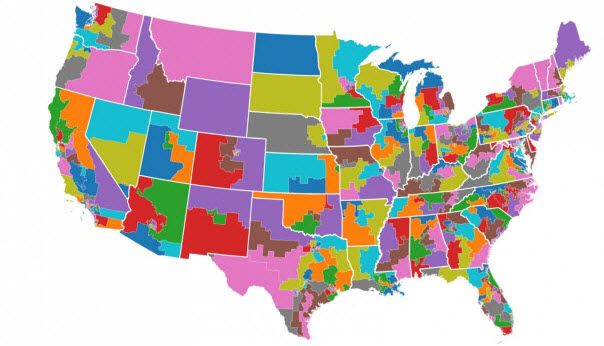
This congressional map shows how districts are now drawn with gerrymandering prevalent in the more populous, Republican-controlled states.
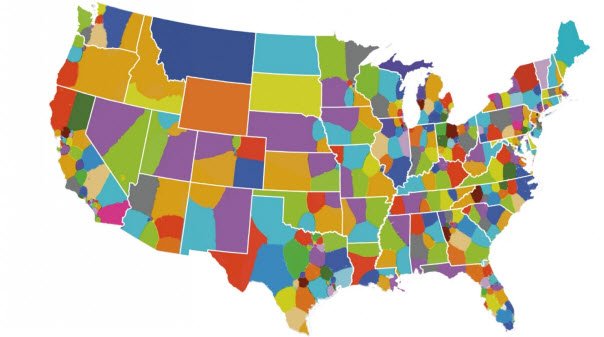
This congressional map shows how districts would be drawn using Brian Olson’s software to create optimally compact equal-population congressional districts in each state, based on 2010 census data. It draws districts that respect the boundaries of census blocks, which are the smallest geographic units used by the Census Bureau. This ensures that the district boundaries reflect actual neighborhoods and don’t cut an arbitrary line through somebody’s house.
May 4 2016 | Posted in
Policy |
Read More »
The contorted shapes that gerrymandering produces are grotesque reminders that our democracy needs an asterisk. The word derives from 1812’s governor of Massachusetts, Elbridge Gerry, who rearranged election districts to his liking. The shape of one of them 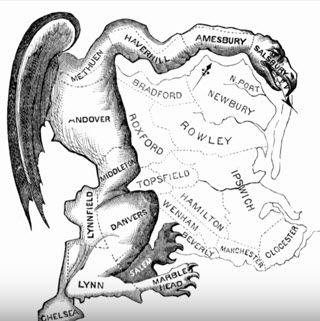
The 1812 cartoon in the Boston Gazette mocking the shape of one of Gov. Gerry’s contrivances.
reminded people of a salamander. Hence Gerrymander.
Here is a selection of the most notoriously contrived to make an election outcome a certainty for the party controlling the process.
Maryland’s 3rd District: As your eye will bear witness, this bug splat is 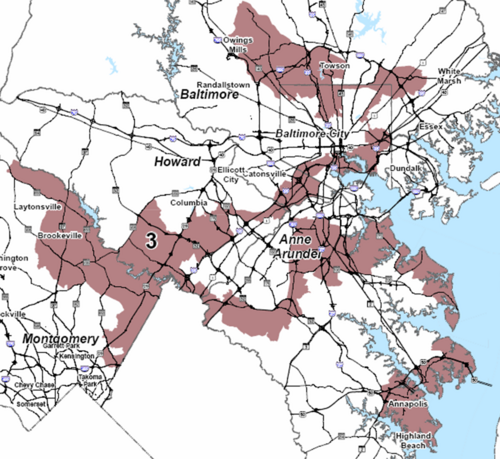
considered the most gerrymandered district in the country. Connected by tiny threads and leaping across water, it consists of parts of Baltimore, Annapolis and three counties. It was constructed to benefit Democrats. It’s John Sarbanes district and was the district of both Maryland senators, Barbara Mikulski and and Ben Cardin, when they were representatives.
North Carolina’s 12th District: The district slices through the center of the state, comprising portions of Charlotte, Winston-Salem and Greensboro, and running right down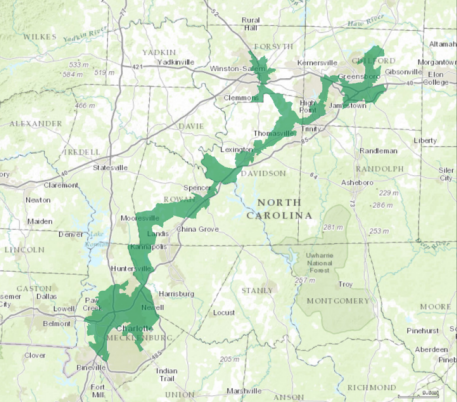
U.S. 85 — so narrow in parts that one state legislator remarked, “if you drove down the interstate with both car doors open, you’d kill most of the people in the district”. The district was designed after the 1990 census to assure that African-Americans in the state would have representation in Congress. In February, the U.S. Circuit Court ruled that, for relying on race, it must be redrawn.
Florida’s 5th District: That a district could stretch from Jacksonville all the way to Orlando tells you that it was designed for a 
suspect purpose. It even consists of sparsely populated areas strung together so as to gather up small African-American neighborhoods, and it culminates in heavily black Jacksonville. In 2014 the Florida Circuit Court ruled that the district had been drawn to collect a maximum number of blacks to make surrounding districts majority-white. Support of that ruling by the Democratic Party drew the ire of 5th District Representative Corrine Brown, who said breaking up her 5th would cost blacks a representative.
Pennsylvania’s 7th District: Another district held together by threads. Two connect three wandering areas of markedly different size. After the 2000 census, the controlling GOP redrew the district map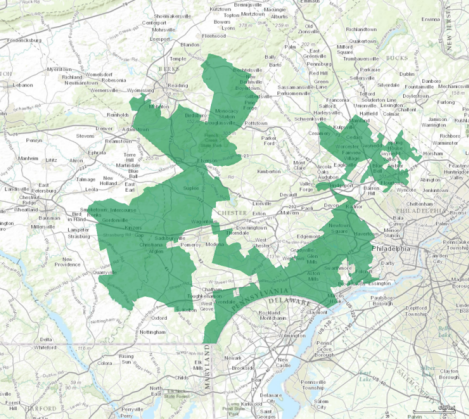
so that, rather than the 10 seats Republicans had held versus 12 held by Democrats, the ratio would change to 12 Republicans vs. 7 Democrats. A group of Democrats sued in Vieth v. Jubelirer, which went to the Supreme Court in 2004. The Justices declined to invalidate the Pennsylvania map and moreover embraced the right of political parties to gerrymander for partisan gain, helping to entrench the polarization of the present day. Justice Antonin Scalia thought that good will out, that “an utterly incompetent candidate will lose even in its registration stronghold”, and that the Constitution is moot on any “right to proportional representation” or that any ethnic or other group “must be accorded political strength proportionate to their numbers”. In other words, if it’s not in the Constitution, anything goes. The result was that gerrymandering led to Pennsylvania Democrats winning only 5 out of 18 congressional House seats, despite winning slightly more than half of the statewide vote.
Illinois’ 4th District: Its shape, wrapping around Chicago, earned 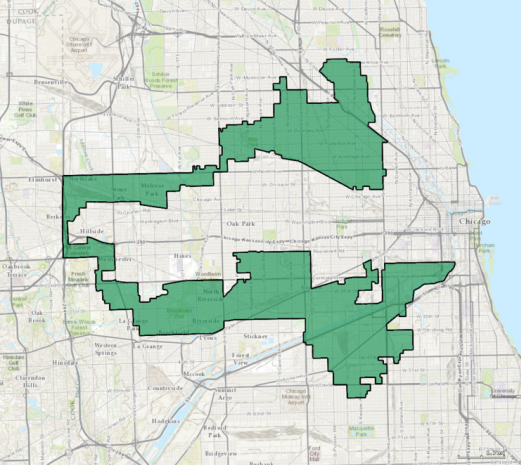
it the nickname “earmuffs”. Its two flaps are connected only by a strip of route 294 at its west end. The district has a long history, dating from 1842. But a district’s shape and location can change significantly with each redrawing. The intent of its present configuration was to pack two parts of Chicago with majority Hispanic populations into one district.
North Carolina’s 1st District: Created in 2013 immediately after 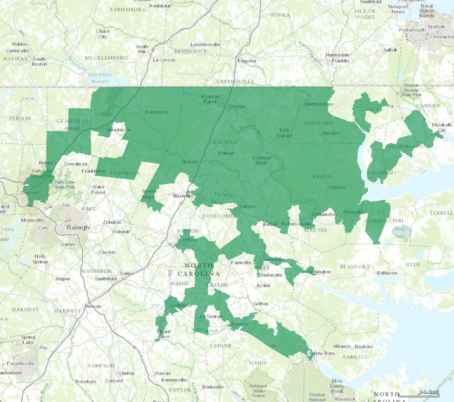
the Supreme Court ended the requirement that a passel of southern states must apply to the Treasury Department for “preclearance” of redistricting plans, the 1st district, like the 12th North Carolina above, was voided by the U.S. Circuit Court in February for gathering populations of like race.
May 4 2016 | Posted in
Policy |
Read More »

















